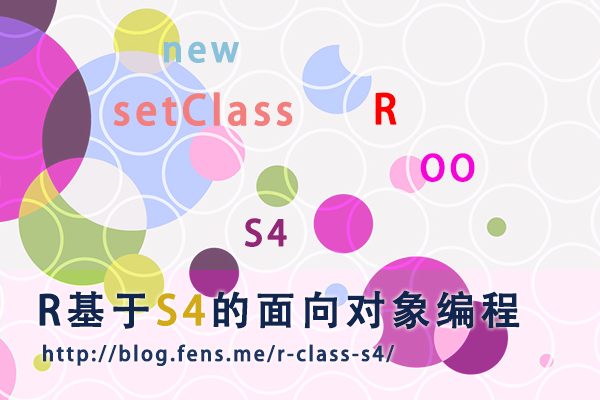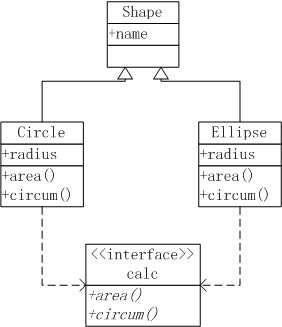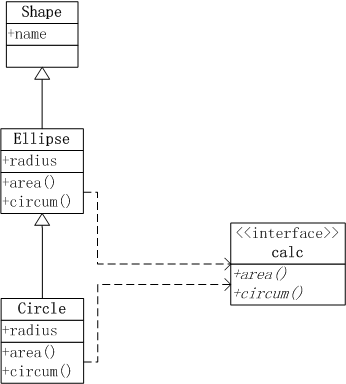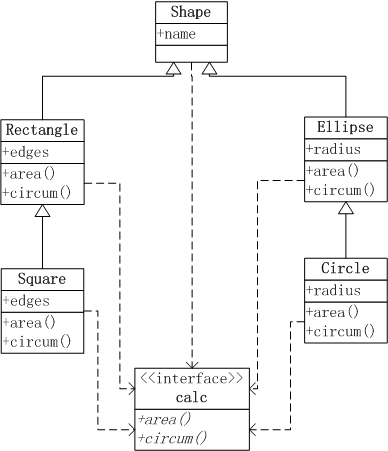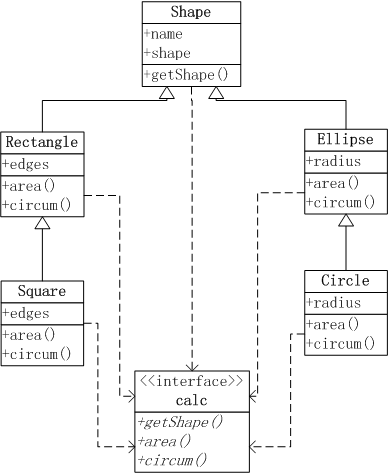R语言基于S4的面向对象编程
Posted holy_black_cat
tags:
篇首语:本文由小常识网(cha138.com)小编为大家整理,主要介绍了R语言基于S4的面向对象编程相关的知识,希望对你有一定的参考价值。
前言
本文接上一篇文章 R语言基于S3的面向对象编程,本文继续介绍R语言基于S4的面向对象编程。
S4对象系统具有明显的结构化特征,更适合面向对象的程序设计。Bioconductor社区,以S4对象系统做为基础架构,只接受符合S4定义的R包。
目录
- S4对象介绍
- 创建S4对象
- 访问对象的属性
- S4的泛型函数
- 查看S4对象的函数
- S4对象的使用
1 S4对象介绍
S4对象系统是一种标准的R语言面向对象实现方式,S4对象有明确的类定义,参数定义,参数检查,继承关系,实例化等的面向对象系统的特征。
2 创建S4对象
本文的系统环境
- Linux: Ubuntu Server 12.04.2 LTS 64bit
- R: 3.0.1 x86_64-pc-linux-gnu
为了方便我们检查对象的类型,引入pryr包作为辅助工具。关于pryr包的介绍,请参考文章:[撬动R内核的高级工具包pryr](http://blog.fens.me/r-pryr/)
# 加载pryr包
> library(pryr)
2.1 如何创建S4对象?
由于S4对象是标准的面向对象实现方式, 有专门的类定义函数 setClass() 和类的实例化函数new() ,我们看一下setClass()和new()是如何动作的。
2.1.1 setClass()
查看setClass的函数定义
setClass(Class, representation, prototype, contains=character(),
validity, access, where, version, sealed, package,
S3methods = FALSE, slots)
参数列表:
- Class: 定义类名
- slots: 定义属性和属性类型
- prototype: 定义属性的默认值
- contains=character(): 定义父类,继承关系
- validity: 定义属性的类型检查
- where: 定义存储空间
- sealed: 如果设置TRUE,则同名类不能被再次定义
- package: 定义所属的包
- S3methods: R3.0.0以后不建议使用
- representation R3.0.0以后不建议使用
- access R3.0.0以后不建议使用
- version R3.0.0以后不建议使用
2.2 创建一个S4对象实例
# 定义一个S4对象
> setClass("Person",slots=list(name="character",age="numeric"))
# 实例化一个Person对象
> father<-new("Person",name="F",age=44)
# 查看father对象,有两个属性name和age
> father
An object of class "Person"
Slot "name":
[1] "F"
Slot "age":
[1] 44
# 查看father对象类型,为Person
> class(father)
[1] "Person"
attr(,"package")
[1] ".GlobalEnv"
# 查看father对象为S4的对象
> otype(father)
[1] "S4"
2.3 创建一个有继承关系的S4对象
# 创建一个S4对象Person
> setClass("Person",slots=list(name="character",age="numeric"))
# 创建Person的子类
> setClass("Son",slots=list(father="Person",mother="Person"),contains="Person")
# 实例化Person对象
> father<-new("Person",name="F",age=44)
> mother<-new("Person",name="M",age=39)
# 实例化一个Son对象
> son<-new("Son",name="S",age=16,father=father,mother=mother)
# 查看son对象的name属性
> [email protected]
[1] "S"
# 查看son对象的age属性
> [email protected]
[1] 16
# 查看son对象的father属性
> [email protected]
An object of class "Person"
Slot "name":
[1] "F"
Slot "age":
[1] 44
# 查看son对象的mother属性
> slot(son,"mother")
An object of class "Person"
Slot "name":
[1] "M"
Slot "age":
[1] 39
# 检查son类型
> otype(son)
[1] "S4"
# 检查[email protected]属性类型
> otype([email protected])
[1] "primitive"
# 检查[email protected]属性类型
> otype([email protected])
[1] "S4"
# 用isS4(),检查S4对象的类型
> isS4(son)
[1] TRUE
> isS4([email protected])
[1] FALSE
> isS4([email protected])
[1] TRUE
2.4 S4对象的默认值
> setClass("Person",slots=list(name="character",age="numeric"))
# 属性age为空
> a<-new("Person",name="a")
> a
An object of class "Person"
Slot "name":
[1] "a"
Slot "age":
numeric(0)
# 设置属性age的默认值20
> setClass("Person",slots=list(name="character",age="numeric"),prototype = list(age = 20))
# 属性age为空
> b<-new("Person",name="b")
# 属性age的默认值是20
> b
An object of class "Person"
Slot "name":
[1] "b"
Slot "age":
[1] 20
2.5 S4对象的类型检查
> setClass("Person",slots=list(name="character",age="numeric"))
# 传入错误的age类型
> bad<-new("Person",name="bad",age="abc")
Error in validObject(.Object) :
invalid class “Person” object: invalid object for slot "age" in class "Person": got class "character", should be or extend class "numeric"
# 设置age的非负检查
> setValidity("Person",function(object) {
+ if ([email protected] <= 0) stop("Age is negative.")
+ })
Class "Person" [in ".GlobalEnv"]
Slots:
Name: name age
Class: character numeric
# 修传入小于0的年龄
> bad2<-new("Person",name="bad",age=-1)
Error in validityMethod(object) : Age is negative.
2.6 从一个已经实例化的对象中创建新对象
S4对象,还支持从一个已经实例化的对象中创建新对象,创建时可以覆盖旧对象的值
> setClass("Person",slots=list(name="character",age="numeric"))
# 创建一个对象实例n1
> n1<-new("Person",name="n1",age=19);n1
An object of class "Person"
Slot "name":
[1] "n1"
Slot "age":
[1] 19
# 从实例n1中,创建实例n2,并修改name的属性值
> n2<-initialize(n1,name="n2");n2
An object of class "Person"
Slot "name":
[1] "n2"
Slot "age":
[1] 19
3 访问对象的属性
在S3对象中,一般我使用$来访问一个对象的属性,但在S4对象中,我们只能使用@来访问一个对象的属性
> setClass("Person",slots=list(name="character",age="numeric"))
> a<-new("Person",name="a")
# 访问S4对象的属性
> [email protected]
[1] "a"
> slot(a, "name")
[1] "a"
# 错误的属性访问
> a$name
Error in a$name : $ operator not defined for this S4 class
> a[1]
Error in a[1] : object of type ‘S4‘ is not subsettable
> a[[1]]
Error in a[[1]] : this S4 class is not subsettable
4 S4的泛型函数
S4的泛型函数实现有别于S3的实现,S4分离了方法的定义和实现,如在其他语言中我们常说的接口和实现分离。通过setGeneric()来定义接口,通过setMethod()来定义现实类。这样可以让S4对象系统,更符合面向对象的特征。
普通函数的定义和调用
> work<-function(x) cat(x, "is working")
> work(‘Conan‘)
Conan is working
让我来看看如何用R分离接口和现实
# 定义Person对象
> setClass("Person",slots=list(name="character",age="numeric"))
# 定义泛型函数work,即接口
> setGeneric("work",function(object) standardGeneric("work"))
[1] "work"
# 定义work的现实,并指定参数类型为Person对象
> setMethod("work", signature(object = "Person"), function(object) cat([email protected] , "is working") )
[1] "work"
# 创建一个Person对象a
> a<-new("Person",name="Conan",age=16)
# 把对象a传入work函数
> work(a)
Conan is working
通过S4对象系统,把原来的函数定义和调用2步,为成了4步进行:
- 定义数据对象类型
- 定义接口函数
- 定义实现函数
- 把数据对象以参数传入到接口函数,执行实现函数
通过S4对象系统,是一个结构化的,完整的面向对象实现。
5 查看S4对象的函数
当我们使用S4对象进行面向对象封装后,我们还需要能查看到S4对象的定义和函数定义。
还以上节中Person和work的例子
# 检查work的类型
> ftype(work)
[1] "s4" "generic"
# 直接查看work函数
> work
standardGeneric for "work" defined from package ".GlobalEnv"
function (object)
standardGeneric("work")
<environment: 0x2aa6b18>
Methods may be defined for arguments: object
Use showMethods("work") for currently available ones.
# 查看work函数的现实定义
> showMethods(work)
Function: work (package .GlobalEnv)
object="Person"
# 查看Person对象的work函数现实
> getMethod("work", "Person")
Method Definition:
function (object)
cat([email protected], "is working")
Signatures:
object
target "Person"
defined "Person"
> selectMethod("work", "Person")
Method Definition:
function (object)
cat([email protected], "is working")
Signatures:
object
target "Person"
defined "Person"
# 检查Person对象有没有work函数
> existsMethod("work", "Person")
[1] TRUE
> hasMethod("work", "Person")
[1] TRUE
6 S4对象的使用
我们接下用S4对象做一个例子,定义一组图形函数的库。
6.1 任务一:定义图形库的数据结构和计算函数
假设最Shape为图形的基类,包括圆形(Circle)和椭圆形(Ellipse),并计算出它们的面积(area)和周长(circum)。
- 定义图形库的数据结构
- 定义圆形的数据结构,并计算面积和周长
- 定义椭圆形的数据结构,并计算面积和周长
如图所示结构:
定义基类Shape 和 圆形类Circle
# 定义基类Shape
> setClass("Shape",slots=list(name="character"))
# 定义圆形类Circle,继承Shape,属性radius默认值为1
> setClass("Circle",contains="Shape",slots=list(radius="numeric"),prototype=list(radius = 1))
# 验证radius属性值要大等于0
> setValidity("Circle",function(object) {
+ if ([email protected] <= 0) stop("Radius is negative.")
+ })
Class "Circle" [in ".GlobalEnv"]
Slots:
Name: radius name
Class: numeric character
Extends: "Shape"
# 创建两个圆形实例
> c1<-new("Circle",name="c1")
> c2<-new("Circle",name="c2",radius=5)
定义计算面积的接口和现实
# 计算面积泛型函数接口
> setGeneric("area",function(obj,...) standardGeneric("area"))
[1] "area"
# 计算面积的函数现实
> setMethod("area","Circle",function(obj,...){
+ print("Area Circle Method")
+ pi*[email protected]^2
+ })
[1] "area"
# 分别计算c1和c2的两个圆形的面积
> area(c1)
[1] "Area Circle Method"
[1] 3.141593
> area(c2)
[1] "Area Circle Method"
[1] 78.53982
定义计算周长的接口和现实
# 计算周长泛型函数接口
> setGeneric("circum",function(obj,...) standardGeneric("circum"))
[1] "circum"
# 计算周长的函数现实
> setMethod("circum","Circle",function(obj,...){
+ 2*pi*[email protected]
+ })
# 分别计算c1和c2的两个圆形的面积
[1] "circum"
> circum(c1)
[1] 6.283185
> circum(c2)
[1] 31.41593
上面的代码,我们实现了圆形的定义,下来我们实现椭圆形。
# 定义椭圆形的类,继承Shape,radius参数默认值为c(1,1),分别表示椭圆形的长半径和短半径
> setClass("Ellipse",contains="Shape",slots=list(radius="numeric"),prototype=list(radius=c(1,1)))
# 验证radius参数
> setValidity("Ellipse",function(object) {
+ if (length([email protected]) != 2 ) stop("It‘s not Ellipse.")
+ if (length(which([email protected]<=0))>0) stop("Radius is negative.")
+ })
Class "Ellipse" [in ".GlobalEnv"]
Slots:
Name: radius name
Class: numeric character
Extends: "Shape"
# 创建两个椭圆形实例e1,e2
> e1<-new("Ellipse",name="e1")
> e2<-new("Ellipse",name="e2",radius=c(5,1))
# 计算椭圆形面积的函数现实
> setMethod("area", "Ellipse",function(obj,...){
+ print("Area Ellipse Method")
+ pi * prod([email protected])
+ })
[1] "area"
# 计算e1,e2两个椭圆形的面积
> area(e1)
[1] "Area Ellipse Method"
[1] 3.141593
> area(e2)
[1] "Area Ellipse Method"
[1] 15.70796
# 计算椭圆形周长的函数现实
> setMethod("circum","Ellipse",function(obj,...){
+ cat("Ellipse Circum :\n")
+ 2*pi*sqrt(([email protected][1]^[email protected][2]^2)/2)
+ })
[1] "circum"
# 计算e1,e2两个椭圆形的周长
> circum(e1)
Ellipse Circum :
[1] 6.283185
> circum(e2)
Ellipse Circum :
[1] 22.65435
6.2 任务二:重构圆形和椭圆形的设计
上一步,我们已经完成了 圆形和椭圆形 的数据结构定义,以及计算面积和周长的方法现实。不知大家有没有发现,圆形是椭圆形的一个特例呢?
当椭圆形的长半径和短半径相等时,即radius的两个值相等,形成的图形为圆形。利用这个特点,我们就可以重新设计 圆形和椭圆形 的关系。椭圆形是圆形的父类,而圆形是椭圆形的子类。
如图所示结构:
# 基类Shape
> setClass("Shape",slots=list(name="character",shape="character"))
# Ellipse继承Shape
> setClass("Ellipse",contains="Shape",slots=list(radius="numeric"),prototype=list(radius=c(1,1),shape="Ellipse"))
# Circle继承Ellipse
> setClass("Circle",contains="Ellipse",slots=list(radius="numeric"),prototype=list(radius = 1,shape="Circle"))
# 定义area接口
> setGeneric("area",function(obj,...) standardGeneric("area"))
[1] "area"
# 定义area的Ellipse实现
> setMethod("area","Ellipse",function(obj,...){
+ cat("Ellipse Area :\n")
+ pi * prod([email protected])
+ })
[1] "area"
# 定义area的Circle实现
> setMethod("area","Circle",function(obj,...){
+ cat("Circle Area :\n")
+ pi*[email protected]^2
+ })
[1] "area"
# 定义circum接口
> setGeneric("circum",function(obj,...) standardGeneric("circum"))
[1] "circum"
# 定义circum的Ellipse实现
> setMethod("circum","Ellipse",function(obj,...){
+ cat("Ellipse Circum :\n")
+ 2*pi*sqrt(([email protected][1]^[email protected][2]^2)/2)
+ })
[1] "circum"
# 定义circum的Circle实现
> setMethod("circum","Circle",function(obj,...){
+ cat("Circle Circum :\n")
+ 2*pi*[email protected]
+ })
[1] "circum"
# 创建实例
> e1<-new("Ellipse",name="e1",radius=c(2,5))
> c1<-new("Circle",name="c1",radius=2)
# 计算椭圆形的面积和周长
> area(e1)
Ellipse Area :
[1] 31.41593
> circum(e1)
Ellipse Circum :
[1] 23.92566
# 计算圆形的面积和周长
> area(c1)
Circle Area :
[1] 12.56637
> circum(c1)
Circle Circum :
[1] 12.56637
我们重构后的结构,是不是会更合理呢!!
6.3 任务三:增加矩形的图形处理
我们的图形库,进一步扩充,需要加入矩形和正方形。
- 定义矩形的数据结构,并计算面积和周长
- 定义正方形的数据结构,并计算面积和周长
- 正方形是矩形的特例,定义矩形是正方形的父类,而正方形是矩形的子类。
如图所示结构:
# 定义矩形Rectangle,继承Shape
> setClass("Rectangle",contains="Shape",slots=list(edges="numeric"),prototype=list(edges=c(1,1),shape="Rectangle"))
# 定义正方形Square,继承Rectangle
> setClass("Square",contains="Rectangle",slots=list(edges="numeric"),prototype=list(edges=1,shape="Square"))
# 定义area的Rectangle实现
> setMethod("area","Rectangle",function(obj,...){
+ cat("Rectangle Area :\n")
+ prod([email protected])
+ })
[1] "area"
# 定义area的Square实现
> setMethod("area","Square",function(obj,...){
+ cat("Square Area :\n")
+ [email protected]^2
+ })
[1] "area"
# 定义circum的Rectangle实现
> setMethod("circum","Rectangle",function(obj,...){
+ cat("Rectangle Circum :\n")
+ 2*sum([email protected])
+ })
[1] "circum"
# 定义circum的Square实现
> setMethod("circum","Square",function(obj,...){
+ cat("Square Circum :\n")
+ 4*[email protected]
+ })
[1] "circum"
# 创建实例
> r1<-new("Rectangle",name="r1",edges=c(2,5))
> s1<-new("Square",name="s1",edges=2)
# 计算矩形形的面积和周长
> area(r1)
Rectangle Area :
[1] 10
> area(s1)
Square Area :
[1] 4
# 计算正方形的面积和周长
> circum(r1)
Rectangle Circum :
[1] 14
> circum(s1)
Square Circum :
[1] 8
这样,我们的图形库,已经支持了4种图形了!用面向对象的结构来设计,是不是结构化思路很清晰呢!!
6.4 任务四:在基类Shape中,增加shape属性和getShape方法
接下来,要对图形库的所有图形,定义图形类型的变量shape,然后再提供一个getShape函数可以检查实例中的是shape变量。
这个需求,如果没有面向对象的结构,那么你需要在所有图形定义的代码中,都增加一个参数和一个判断,如果有100图形,改起来还是挺复杂的。而面向对象的程序设计,就非常容易解决这个需求。我们只需要在基类上改动代码就可以实现了。
如图所示结构:
# 重新定义基类Shape,增加shape属性
> setClass("Shape",slots=list(name="character",shape="character"))
# 定义getShape接口
> setGeneric("getShape",function(obj,...) standardGeneric("getShape"))
[1] "getShape"
# 定义getShape实现
> setMethod("getShape","Shape",function(obj,...){
+ cat([email protected],"\n")
+ })
[1] "getShape"
其实,这样改动一个就可以了,我们只需要重实例化每个图形的对象就行了。
# 实例化一个Square对象,并给shape属性赋值
> s1<-new("Square",name="s1",edges=2, shape="Square")
# 调用基类的getShape()函数
> getShape(r1)
Rectangle
是不是很容易的呢!在代码只在基类里修改了,所有的图形就有了对应的属性和方法。
如果我们再多做一步,可以修改每个对象的定义,增加shape属性的默认值。
setClass("Ellipse",contains="Shape",slots=list(radius="numeric"),prototype=list(radius=c(1,1),shape="Ellipse"))
setClass("Circle",contains="Ellipse",slots=list(radius="numeric"),prototype=list(radius = 1,shape="Circle"))
setClass("Rectangle",contains="Shape",slots=list(edges="numeric"),prototype=list(edges=c(1,1),shape="Rectangle"))
setClass("Square",contains="Rectangle",slots=list(edges="numeric"),prototype=list(edges=1,shape="Square"))
再实例化对象时,属性shape会被自动赋值
# 实例化一个Square对象
> s1<-new("Square",name="s1",edges=2)
# 调用基类的getShape()函数
> getShape(r1)
Rectangle
下面是完整的R语言的代码实现:
setClass("Shape",slots=list(name="character",shape="character"))
setClass("Ellipse",contains="Shape",slots=list(radius="numeric"),prototype=list(radius=c(1,1),shape="Ellipse"))
setClass("Circle",contains="Ellipse",slots=list(radius="numeric"),prototype=list(radius = 1,shape="Circle"))
setClass("Rectangle",contains="Shape",slots=list(edges="numeric"),prototype=list(edges=c(1,1),shape="Rectangle"))
setClass("Square",contains="Rectangle",slots=list(edges="numeric"),prototype=list(edges=1,shape="Square"))
setGeneric("getShape",function(obj,...) standardGeneric("getShape"))
setMethod("getShape","Shape",function(obj,...){
cat([email protected],"\n")
})
setGeneric("area",function(obj,...) standardGeneric("area"))
setMethod("area","Ellipse",function(obj,...){
cat("Ellipse Area :\n")
pi * prod([email protected])
})
setMethod("area","Circle",function(obj,...){
cat("Circle Area :\n")
pi*[email protected]^2
})
setMethod("area","Rectangle",function(obj,...){
cat("Rectangle Area :\n")
prod([email protected])
})
setMethod("area","Square",function(obj,...){
cat("Square Area :\n")
[email protected]^2
})
setGeneric("circum",function(obj,...) standardGeneric("circum"))
setMethod("circum","Ellipse",function(obj,...){
cat("Ellipse Circum :\n")
2*pi*sqrt(([email protected][1]^[email protected][2]^2)/2)
})
setMethod("circum","Circle",function(obj,...){
cat("Circle Circum :\n")
2*pi*[email protected]ius
})
setMethod("circum","Rectangle",function(obj,...){
cat("Rectangle Circum :\n")
2*sum([email protected])
})
setMethod("circum","Square",function(obj,...){
cat("Square Circum :\n")
4*[email protected]
})
e1<-new("Ellipse",name="e1",radius=c(2,5))
c1<-new("Circle",name="c1",radius=2)
r1<-new("Rectangle",name="r1",edges=c(2,5))
s1<-new("Square",name="s1",edges=2)
area(e1)
area(c1)
circum(e1)
circum(c1)
area(r1)
area(s1)
circum(r1)
circum(s1)
通过这个例子,我们全面地了解了R语言中面向对象的使用,和S4对象系统的面向对象程序设计!
在程序员的世界里,世间万物都可以抽象成对象。
http://blog.fens.me/r-class-s4/
以上是关于R语言基于S4的面向对象编程的主要内容,如果未能解决你的问题,请参考以下文章
